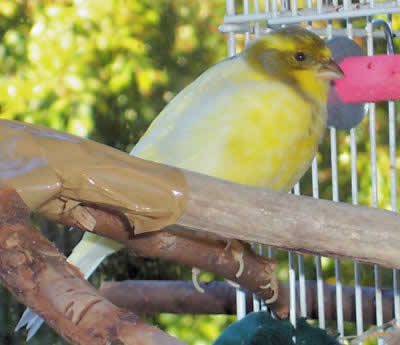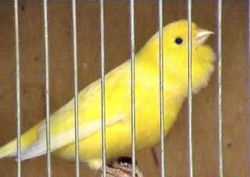
When people think of a”singing canary”, the bird that most often comes to mind is the popular Roller Canary!
The Roller Canary, also called the German Roller Canary or the Hartz Mountain Roller Canary, has been highly prized for hundreds of years for its beautiful song. It is one of the older and best known of the canary breeds. Not only does it have a great song but is also quite good at mimicry. So for birds that will be entered into shows great care must be taken that they learn the proper songs. In the past to train a Roller Canary to sing, a young male bird just past its first molt was kept near an adult male with a perfect song, called the ‘schoolmaster’. The youngster would hear and learn from the repetitive singing of the adult. Today this training is mostly done by using recordings.
The Roller Canary is one of several well known “song canaries”, those bred solely for song rather than physical appearance or color. Shows for these birds are of a different nature than shows for other canary types. Basically being entered into singing contests these canaries are bred with the goal of achieving winners with the best balance between quality and variety of song. Each breed has a distinctive song and a well-defined song standard. Some of the other well know song canaries include: the the Waterslager Canary, the Russian Singer Canary, the American Singer Canary, and the Spanish Timbrado.
For more information about the care of Canaries see:
Guide to a Happy, Healthy Canary
- Kingdom: Animalia
- Phylum: Actiniform
- Class: Elasmobranchii
- Order: Passeriformes
- Family: Fringillidae
- Genus: Serinus
- Species: canaria
Scientific Name:
Distribution:
Originally known as the German Canary, the Roller Canary was developed in the Tyrol region of Germany. In the 1800’s its development became centered in the Hartz Mountains where several hundred families were dedicated to the breeding and training of these birds. In the early 1900’s they were considered the finest of all singers and began to be exported all over the world. By 1922 a song standard had emerged, where they are trained to sing well defined passages or type segments, called ‘tours’. There are thirteen tours by British stands, though no one bird can sing them all. Each tour is delivered in a continuously rolling manner, thus the name of these birds being ‘roller’.
Description:
As the Roller Canary is bred solely for its song no concern is given to size, color, or feathering. Consequently they can vary greatly in their appearance. In general however they are quite consistent in having a rather flat head, straight back, and good feather quality. They are a small canary reaching lengths of about 4 1/2 to 5 inches (11.4 – 12.7 cm). They can be predominantly green, or mixed in color ranging anywhere between green to a clear yellow.
The wonderful song of the Roller Canary is distinct and melodic, less shrill and choppy than the songs of other canaries. It sings with its beak closed giving it a lower timbre which is what makes it so pleasing to the human ear.
Canaries of both sexes can begin to sing a weak song as early as four weeks, but females usually don’t sing after about six months and won’t have the full long song of a male.

Roller Canary
Photo Courtesy David S Godman,
New Zealand Roller Canary Breeder Exhibitor
Care and feeding:
Canaries like wide open spaces so provide a roomy cage. Provide a cage with vertical bars and small perches of different size for foot exercise. Have at least 1 perch set high in the cage for the canary to roost (sleep). The cage should be placed high, so the canary can look down on us so to speak.
The best temperature range for a Roller Canary is 50° – 70° F with lots of natural daylight. Keeping them on the warmer side, around to 72° F, will cause them to be constantly in a soft molt.
Canaries eat mainly canary seed and rape seed. Vitamin coated canary seed mixes are readily available at a pet store. Greens are also enjoyed and can be offered daily along with a little calcium in the form of a cuttlebone.
They do like to bath, so should be offered a bird bath.Cage cleaning and toe nail trimming is about all the maintenance canaries need.
See About Canaries: Housing and About Canaries: Care and Feeding for more information.
Social Behaviors:
They are good-natured social creatures that do well when kept in cages or in aviaries. They are timid birds though and should not be housed with parakeets, lovebirds, or other hookbills that tend to be more aggressive birds by nature.
Male canaries should be kept in a cage by themselves to ensure quality singing. Males can be territorial and pairing up with two male canaries in a cage can cause fights. In a spacious aviary canaries can generally be housed with other canaries, finches, and other hardbills.
Activities:
Canaries do not require toys, mirrors or any other form of entertainment, a swing is all they need to keep themselves occupied. Most of the time, canaries are simply enjoyed for their beauty and singing. However, some canaries are allowed out of their cage to perch or are show canaries and therefore require taming or training.
For singing contests the Roller Canary requires a great deal of training. They are trained to sing well defined song segments, called ‘tours. They can be trained either from listening to another perfect adult singer or from a recording. As they are also quite adept at mimicry, If they develop any faults in the song they must immediately be removed from any other birds being trained.
See About Canaries: Handling/Training for information on taming and training.
Breeding/Reproduction:
Roller Canaries are free breeding and are similar to breeding other canaries. Most canaries breed easily and readily if provided with quality food, lighting, secure surroundings, and conditioning. They are best bred in breeding cages. They lay their eggs in a nest. The female will lay 4 to 5 eggs, one per day. Breeding season usually commences in March for the Roller Canary, it is best to allow a hen to have only two clutches.
See About Canaries: Breeding/Reproduction for more information on breeding.
Here’s a similar
looking singer!
Waterslager Canary
Photo©Animal-World:
Courtesy Richard Rolloff
Potential Problems:
These birds are hardy and healthy if provided with a good environment and a good diet. Avoid an environment that is wet, cool, and drafty.
See About Canaries: Potential Problems for information on health.
Availability:
Roller Canaries are readily available and are best purchased in November which is shortly after they have finished their molt. Prices ranges starting at about $60 or more for a female and $70 or more for a male. Sometimes available at pet stores, but more readily they can be found through breeders, bird shows, bird clubs, and on the internet.
Featured Image Credit: susin micallef, Shutterstock
